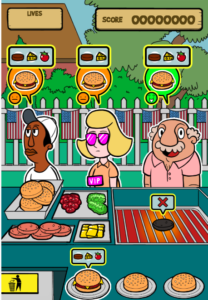Fifth Tribe’s services range from branding, product and web/mobile development, to digital marketing. Included in these capabilities are our unique skills in game creation – you heard me right. Games! Sounds fun, right? It is!
We create, build, and launch 6-8 games per year for one of our largest clients, Regency Furniture. These promotional games, which go live on the Regency Furniture Deals website, are innovative, comprehensive digital marketing techniques designed to increase customer traffic and sales. Created specifically for the Regency Furniture brand, the games are a means of organically strengthening the brand while incentivizing players to participate in an interactive competition for discount codes and free merchandise. The games bring potential clients to the Regency Furniture website, increasing the likelihood for more sales and obtaining email addresses for distribution lists.

I sat down with Asif Khan, Chief Technology Officer and project innovation leader, and Stuart Lindstrom, our front-end developer, to learn more about how we build these games. I was specifically interested in our summer project, Regency’s Burger Club.
Step 1: Brainstorming
A brainstorming session kicks off Fifth Tribe’s game creation process. This creative session includes the entire Fifth Tribe team, and we come together to brainstorm ideas that relate to the designated brand (in this case, Regency Furniture) and any relevant holidays, seasons, events, etc. For example, Burger Club was born out of a creative session in early summer when the Fifth Tribe team gathered and shared “summer themed” activities, like barbequing and swimming, and upcoming holidays, such as the Fourth of July.
Typically, this brainstorming meeting results in more than 20 ideas. Asif and Stuart will narrow this list down based on what they know about the client and our capabilities, and the client will approve their favorite ideas.

Early graphic mockups for Burger Club.

Later iterations of graphics for Burger Club.
Step 2: Prototyping
According to Asif and Stuart, the entire game creation process is highly iterative. These iterations start with the prototyping of a rough version of the selected concept. The person who takes the reins on the early development depends entirely on who is working on what; for instance, Asif led the first few iterations of Regency’s Burger Club because Stuart was working on a project for another client. However, Stuart came in for later iterations for some “clean up” and to take the prototyped version to the final version.
For game design, Fifth Tribe works exclusively with JavaScript and Phaser. Oftentimes, we will use structures of games that are similar to projects that we have previously developed, but the concept and design will always be original. For instance, we had done something comparable to Burger Club in the past, but there was a lot of re-coding that had to be done. Asif explained that these iterations are necessary because so much knowledge is gained over time; in other words, we’ve optimized a lot of our skills and have learned so much over the past year. The design of Burger Club needed to reflect these improvements.

Example of final graphics for Regency’s Burger Club.
Step 3: Implementing Graphics
When asked about when and how graphics come into the game design picture, Stuart shared that graphics are designed once there is a strong coding foundation for the game. For Burger Club, we worked with a freelance designer whom we’ve partnered with before. After a conversation about game concept and visuals, she created a handful of samples. These were shared with the Fifth Tribe team and we voted for our favorite options. The selected graphics were then sent back to the freelancer, and she went into game production: i.e. creating the graphics that would appear in the game.

Step 4: Bringing Everything Together
Once the final graphics are produced, it’s time for everything to come together; in this step, Stuart and Asif implement all components – graphics, UI, effects, sounds, etc. – into the game. They ensure that small details like animations and timing are optimized before sharing the product internally with Fifth Tribe.
Step 5: User Testing
Especially when new concepts are being tested, the user testing phase is incredibly important. New games are shared with Fifth Tribe, whose members then play the game and report back their experiences and bugs or glitches that they might have found. Asif and Stuart will continue to iterate the game based on this feedback until we are proud of the final product.
Step 6: Client Approval & Launch
The last step in our game creation process is to share our product with the client. If they have any feedback, we will implement their suggestions until we receive their approval. Then, we will launch the game!
For Regency Burger Club, the game creation process took us around 3 weeks from start to finish. Asif told me that this timeline largely depends on how solidified the concept is following the brainstorming session; the more prototyping that needs to be done, the more time that development will take! Burger Club was relatively conceptualized from the start, so development and design were smooth processes.
Asif and Stuart shared that their favorite part about creating games is the creativity that they have the chance to exercise. Shoutout to these two developers for turning innovative ideas into reality!
Check out the final version of Regency’s Burger Club here!


